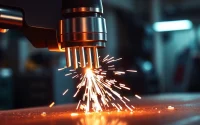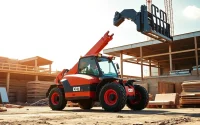Mastering the Needle Gun: Techniques for Efficient Surface Preparation
Understanding the Needle Gun
What Is a Needle Gun?
A needle gun is a powerful hand tool designed specifically for surface preparation tasks. Unlike its namesake firearms, which feature a needle-like firing pin, this tool utilizes a series of rapidly moving steel needles to remove unwanted materials such as rust, paint, and other contaminants from metal surfaces. The operation of a needle gun typically involves compressed air, enhancing efficiency and velocity, which are vital for industrial applications.
Commonly referred to as a needle scaler, the needle gun is primarily used in metalworking and construction industries. Its design is tailored to tackle tough surfaces that require thorough cleaning without damaging the underlying material. The needles, usually made from hardened steel, strike the surface at high speeds, effectively dislodging debris and uneven coatings.
Key Features and Benefits
Needle guns come with several distinct features that improve usability and effectiveness. Key benefits include:
- High Efficiency: Capable of removing heavy rust and scale rapidly, saving time compared to manual scraping methods.
- Lightweight Design: Easy to handle in various user positions, reducing user fatigue during prolonged work periods.
- Versatility: Effective for a variety of applications, including automotive repair, shipyard work, and refurbishment of equipment.
- Cost-Effective: Properly maintained, needle guns have a long lifespan, resulting in lower total cost of ownership.
- Low Maintenance: With simple maintenance requirements, users can keep the tool in optimal working condition with minimal effort.
The History of Needle Guns in Industry
The concept of needle guns dates back to earlier industrial processes, but their modern adaptation has evolved significantly. Originally, the term “needle gun” referred to a specific type of firearm, notably the Dreyse needle gun, used in the 19th century. However, over time, the term came to also encompass tools that utilized similar mechanisms in a non-portable context.
In industrial settings, needle guns were developed to address the need for effective surface cleaning in the growing metal fabrication sector. As industries advanced during the 20th century, especially post-World War II, the demand for efficient metal processing tools surged. Consequently, manufacturers began designing pneumatic tools that utilized the same principles of rapid percussion originally seen in military firearms, thus ushering in the age of powered needle guns.
Choosing the Right Needle Gun for Your Needs
Types of Needle Guns Available
Needle guns come in various types, each tailored for specific applications and users. The main categories include:
- Pneumatic Needle Guns: These utilize compressed air as their power source. They offer a significant advantage in speed and efficiency, making them suitable for heavy-duty tasks.
- Electric Needle Guns: These harness electrical power, providing an alternative for environments where air compressors are impractical. They are generally easier to maintain but may require electrical outlets.
- Battery-Powered Needle Guns: A recent innovation, battery-operated models provide mobility and reduce the need for external power sources. However, their power and efficiency may be less than that of pneumatic models.
- Heavy-Duty Models: Designed for industrial environments where maximum performance is crucial, these versions may come with more robust components to withstand repetitive use.
Essential Specifications to Consider
When selecting a needle gun, consider the following specifications to ensure it meets your operational needs:
- Air Consumption: Typically measured in cubic feet per minute (CFM), select a model that requires compatible airflow from your compressor.
- Operating Pressure: Identify the appropriate pressure range for your applications, usually specified in PSI (pounds per square inch).
- Needle Count and Diameter: More needles or larger diameters can increase productivity but also may require more air power and cause greater surface impact.
- Weight: Consider the tool’s weight, especially for extended use, to reduce strain on the user.
- Ergonomics: Grips and handles should allow for comfortable operation over longer work sessions.
Top Brands and Models in the Market
Several manufacturers stand out in the needle gun market, each offering a variety of models tailored for different applications. Some prominent brands include:
- Ingersoll Rand: Known for its high-quality pneumatic tools, including needle scalers that excel in efficiency.
- Chicago Pneumatic: Offers a range of reliable needle guns, widely used in automotive and manufacturing industries.
- Campbell Hausfeld: Provides affordable models that do not compromise on quality, suitable for both home and professional use.
- Von Arx: Specializes in robust models designed for heavy-duty industrial use, ideal for construction projects where performance is paramount.
How to Use a Needle Gun Effectively
Safety Precautions Before Getting Started
Operating a needle gun can pose hazards; therefore, it’s essential to follow safety protocols:
- Personal Protective Equipment (PPE): Always wear safety goggles, gloves, and ear protection to guard against flying debris and noise.
- Work Environment: Ensure the work area is well-ventilated and free of flammable materials to avoid ignition from sparks.
- Tool Inspection: Before use, inspect the needle gun for any signs of wear or damage, ensuring safe operation.
- Proper Training: Only trained personnel should operate the tool to prevent accidents and ensure effective use.
Step-by-Step Guide to Operating a Needle Gun
Follow these steps to operate a needle gun effectively:
- Prepare the Work Area: Clear away any unnecessary equipment and ensure your workpiece is secure.
- Connect the Air Supply: Attach the needle gun to a compatible air compressor, ensuring the required PSI is set.
- Adjust the Needle Configuration (if applicable): Choose the number and type of needles based on the task.
- Test the Tool: Verify the gun’s operation on a scrap piece before proceeding to your main workpiece.
- Begin Working: Start from one edge and work systematically across the surface, letting the needles do the work. Avoid pressing too hard, allowing the gun’s speed to cover the area efficiently.
- Check Work Regularly: Pause periodically to assess your progress and adjust techniques as necessary.
Common Mistakes and How to Avoid Them
Many users make errors that can impact the effectiveness of the needle gun. Here are common mistakes and tips to avoid them:
- Inadequate Air Supply: Ensure that your compressor can provide the necessary CFM and PSI. A drop in airflow leads to reduced efficiency.
- Overreliance on Pressure: Applying too much pressure can damage surfaces and prematurely wear out needles.
- Neglecting Tool Maintenance: Regular maintenance, such as needle replacement and cleaning, is crucial for optimal performance.
- Working Without PPE: Always prioritize safety by wearing appropriate gear, despite the perceived minor risk.
Maintenance and Care for Your Needle Gun
Routine Maintenance Procedures
Routine maintenance is essential to ensure a long lifespan for your needle gun. Here’s how to maintain it effectively:
- Clean After Use: Wipe down the exterior to remove dust and debris, and clean the needles to prevent contamination.
- Inspect Needles: Regularly check for bends or deformation and replace as needed. Dull or damaged needles decrease efficiency.
- Lubricate Moving Parts: Follow the manufacturer’s recommendations for lubrication schedules, which helps maintain smooth operation.
- Check Air Connections: Ensure that hoses and connections are tight and leak-free to maintain consistent performance.
Identifying Signs of Wear and Damage
Understanding how to identify wear and damage can save you from costly repairs or replacements:
- Inconsistent Performance: If the needle gun struggles to operate or produces less power, it may indicate a problem.
- Visible Damage: Check for cracks in the housing or signs of corrosion, and replace parts as necessary.
- Excess Noise: Increased noise levels can indicate internal issues, warranting immediate inspection.
- Needle Wear: Regularly check the tips of the needles; if they appear worn down, replace them to maintain effectiveness.
Best Practices for Longevity
To enhance the lifespan of your needle gun, consider the following best practices:
- Follow Manufacturer Guidelines: Always adhere to the maintenance and operation instructions provided by the manufacturer.
- Store Properly: Keep the needle gun in a dry place when not in use, protecting it from moisture that could cause rust.
- Limit Exposure: Avoid using the needle gun for purposes outside of its intended design to prevent undue stress on the tool.
- Train Users: Ensure all operators understand the equipment and its care to promote responsible usage.
Applications of Needle Guns in Various Industries
Construction and Metal Fabrication
In the construction and metal fabrication industries, needle guns are invaluable for surface preparation:
Whether working on steel beams, welding seams, or preparing metal for coating, needle guns effectively remove old paint, grime, and rust, ensuring surfaces are clean and ready for further processing. This is crucial not only for aesthetics but also for the longevity of the materials involved.
Aerospace and Automotive Repairs
The aerospace and automotive sectors utilize needle guns to maintain high-quality standards in their repairs and restorations:
With the precision required for these industries, needle guns allow mechanics to prepare surfaces before applying new coatings or treatments, ensuring adhesion and performance are optimal. This process is especially critical where lightweight and strong materials are involved, as any contaminant left behind could lead to operational failures.
Restoration Projects and DIY Uses
Beyond industrial applications, needle guns have found a place in DIY restoration projects:
Whether revitalizing old furniture, cleaning up antique vehicles, or restoring classic machinery, hobbyists can utilize needle guns to bring new life to their projects. Their ability to quickly and effectively clean surfaces makes them a favorite among enthusiasts seeking to achieve professional results at home.


